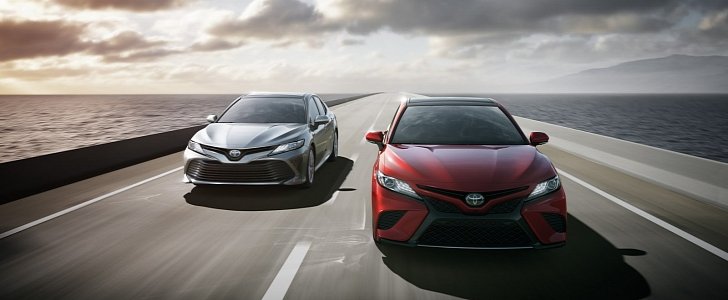It’s been quite some time since the Camry left Western Europe, but the mid-size sedan is coming back despite the fact people are flocking to buy crossovers and SUVs. And as you would expect from an automaker that announced diesel is not long for this world, the Camry will be offered in this part of the world as a hybrid.
The eighth generation of the Camry was launched in Japan in July 2017 while North American production commenced one month earlier. And just like the Japanese and American models, the European version will combine the A25A-FXS engine (2.5-liter four-cylinder) with an electric motor that drives the front wheels.
With 176 horsepower and 163 pound-feet on tap from the internal combustion engine and the assistance of the electric motor, combined output stands at 208 horsepower. Combined fuel economy is another strong point of the Camry Hybrid, rated by the boffins at the Environmental Protection Agency at 52 miles per gallon.
Scheduled to go on sale in the first half of 2019 in Europe’s western markets and the United Kingdom, the Camry Hybrid comes with an electronically controlled Continuously Variable Transmission (eCVT) featuring sequential shift mode. Starting at $27,950 in the United States for the Hybrid LE configuration, it’s too early to guesstimate how much the European model will cost.
Imported from Japan and acting as an indirect replacement for the UK-manufactured Avensis, the Camry Hybrid won’t be available as a station wagon. The question is, why did Toyota choose the 4,885-millimeter long Camry Hybrid instead of something more attractive to most buyers in the mid-size sedan segment?
According to the automaker, fleet customers demand such a vehicle thanks to the low-CO2 drivetrain option. And with lesser carbon dioxide emissions comes lower taxation, bringing the point home for fleet operators and people who can't stand the styling of the Prius.
Bringing the Camry back to Europe expands Toyota’s European lineup of hybrid vehicles to eight models. With annual sales of more than 700,000 examples per year, the Camry remains the best-selling sedan in the D/E segments by a significant margin. Since it first went on sale in 1982, the Japanese automaker tapped the Camry into more than 100 markets, with sales totaling more than 19 million units.
With 176 horsepower and 163 pound-feet on tap from the internal combustion engine and the assistance of the electric motor, combined output stands at 208 horsepower. Combined fuel economy is another strong point of the Camry Hybrid, rated by the boffins at the Environmental Protection Agency at 52 miles per gallon.
Scheduled to go on sale in the first half of 2019 in Europe’s western markets and the United Kingdom, the Camry Hybrid comes with an electronically controlled Continuously Variable Transmission (eCVT) featuring sequential shift mode. Starting at $27,950 in the United States for the Hybrid LE configuration, it’s too early to guesstimate how much the European model will cost.
Imported from Japan and acting as an indirect replacement for the UK-manufactured Avensis, the Camry Hybrid won’t be available as a station wagon. The question is, why did Toyota choose the 4,885-millimeter long Camry Hybrid instead of something more attractive to most buyers in the mid-size sedan segment?
According to the automaker, fleet customers demand such a vehicle thanks to the low-CO2 drivetrain option. And with lesser carbon dioxide emissions comes lower taxation, bringing the point home for fleet operators and people who can't stand the styling of the Prius.
Bringing the Camry back to Europe expands Toyota’s European lineup of hybrid vehicles to eight models. With annual sales of more than 700,000 examples per year, the Camry remains the best-selling sedan in the D/E segments by a significant margin. Since it first went on sale in 1982, the Japanese automaker tapped the Camry into more than 100 markets, with sales totaling more than 19 million units.































